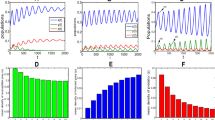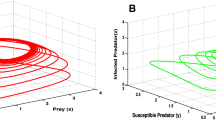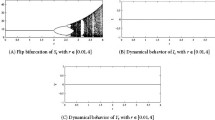Abstract
In this paper, we investigate the complex dynamics of a predator–prey model with disease in the prey, which is characterized by the reduction of prey growth rate due to the anti-predator behavior. The value of this study lies in two aspects: Mathematically, it provides the existence and the stability of the equilibria and gives the existence of Hopf bifurcation. And epidemiologically, we find that the influence of the fear factor is complex: (i) The level of the population density decreases with the increasing of the fear factor; (ii) the cost of fear can destabilize the stability and benefit the emergency of the periodic behavior; and (iii) the high level of fear can induce the extinction of the predator. These results may enrich the dynamics of the eco-epidemiological systems.








Similar content being viewed by others
References
Bairagi, N., Adak, D.: Complex dynamics of a predatorcpreycparasite system: an interplay among infection rate, predator’s reproductive gain and preference. Ecol. Complex. 22, 1–12 (2015)
Bate, A.M., Hilker, F.M.: Complex dynamics in an eco-epidemiological model. Bull. Math. Biol. 75, 2059–2078 (2013)
Bulai, I.M., Hilker, F.M.: Eco-epidemiological interactions with predator interference and infection. Theor. Popul. Biol. 130, 191–202 (2019)
Buonomo, B., d’Onofrio, A., Lacitignola, D.: Global stability of an sir epidemic model with information dependent vaccination. Math. Biosci. 216(1), 9–16 (2008)
Cai, Y., Gui, Z., Zhang, X., Shi, H., Wang, W.M.: Bifurcations and pattern formation in a predator-prey model. Inter. J. Bifurc. Chaos 28, 1850140 (2018)
Cai, Y., Li, J., Kang, Y., Wang, K., Wang, W.: The fluctuation impact of human mobility on the influenza transmission. J. Franklin Inst. 357, 8899–8924 (2020)
Creel, S., Christianson, D.: Relationships between direct predation and risk effects. Trends Ecol. Evol. 23(4), 194–201 (2008)
Diekmann, O., Heesterbeek, J.A.P., Metz, J.A.J.: On the definition and the computation of the basic reproduction ratio \(R_0\) in models for infectious diseases in heterogeneous populations. J. Math. Biol. 28(4), 365–382 (1990)
Greenhalgh, D., Haque, M.: A predator-prey model with disease in the prey species only. Math. Meth. Appl. Sci. 30(8), 911–929 (2007)
Hadeler, K.P., Freedman, H.I.: Predator-prey populations with parasitic infection. J. Math. Biol. 27(6), 609–631 (1989)
Haque, M., Jin, Z., Venturino, E.: An ecoepidemiological predator-prey model with standard disease incidence. Math. Meth. Appl. Sci. 32(7), 875–898 (2009)
Hethcote, H.W., Wang, W., Han, L., Ma, Z.: A predator-prey model with infected prey. Theor. Popu. Biol. 66(3), 259–268 (2004)
Hilker, F.M., Schmitz, K.: Disease-induced stabilization of predator-prey oscillations. J. Theor. Biol. 255, 299–306 (2008)
Kaiser, J.: Salton sea: Battle over a dying sea. Science 284, 28–30 (1999)
Ko, W., Ryu, K.: Qualitative analysis of a predator-prey model with Holling type II functional response incorporating a prey refuge. J. Differ. Eq. 231(2), 534–550 (2006)
Krishchenko, A.P., Starkov, K.E.: Convergence dynamics in one eco-epidemiological model: Self-healing and some related results. Commun. Nonlinear Sci. 85, 105223 (2020)
Kuang, Y., Beretta, E.: Global qualitative analysis of a ratio-dependent predator-prey system. J. Math. Biol. 36, 389–406 (1998)
Kumar, A., Dubey, B.: Modeling the effect of fear in a prey-predator system with prey refuge and gestation delay. Inter. J. Bifur. Chaos 29(14), 1950195 (2019)
Lafferty, K.D., Morris, A.K.: Altered behavior of parasitized killifish increases susceptibility to predation by bird final hosts. Ecology 77, 1390–1397 (1996)
Lima, L.S.: Nonlethal effects in the ecology of predator-prey interactions. Bioscience 48(1), 25–34 (1998)
Malchow, H., Petrovskii, S., Venturino, E.: Spatiotemporal patterns in ecology and epidemiology-theory, models, and simulation. Chapman & Hall/CRC, Boca Raton (2008)
Murray, J.D.: Mathematical biology. Springer-Verlag, New York (1993)
Peterson, R.O., Page, R.E.: Wolf density as a predictor of predation rate. Swed. Wild. Res. 1, 771–773 (1987)
Qiao, T., Cai, Y., Fu, S., Wang, W.M.: Stability and hopf bifurcation in a predator-prey model with the cost of anti-predator behaviors. Inter. J. Bifurc. Chaos 29, 1950185 (2019)
Sasmal, S.: Population dynamics with multiple Allee effects induced by fear factors induced by fear factors-a mathematical study on prey-predator. Appl. Math. Model. 64, 1–14 (2018)
Shaikh, A.A., Das, H., Ali, N.: Study of lg-holling type iii predator-prey model with disease in predator. J. Appl. Math. Comput. 58(1–2), 235–255 (2018)
Sharma, S., Samanta, G.P.: A Leslie-Gower predator-prey model with disease in prey incorporating a prey refuge. Chaos. Solit. Fract. 70, 69–84 (2015)
Sheriff, M.J., Krebs, C.J., Boonstra, R.: The sensitive hare: sublethal effects of predator stress on reproduction in snowshoe hares. J. Anim. Ecol. 78(6), 1249–1258 (2009)
Sieber, M., Malchow, H., Hilker, F.M.: Disease-induced modification of prey competition in eco-epidemiological models. Ecol. Complex. 8, 74–82 (2014)
Upadhyay, R., Mishra, S.: Population dynamic consequences of fearful prey in a spatiotemporal predator-prey system. Math. Biosci. Eng. 16(1), 338–372 (2018)
Van den Driessche, P., Watmough, J.: Reproduction numbers and sub-threshold endemic equilibria for compartmental models of disease transmission. Math. Biosci. 180(1), 29–48 (2002)
Venturino, E., Volpert, V.: Ecoepidemiology: a more comprehensive view of population interactions. Math. Model. Nat. Phenom. 11, 49–90 (2016)
Wang, J., Cai, Y., Fu, S., Wang, W.M.: The effect of the fear factor on the dynamics of a predator-prey model incorporating the prey refuge. Chaos 29(8), 083109 (2019)
Wang, X., Tan, Y., Cai, Y., Wang, W.M.: Impact of the fear effect on the stability and bifurcation of a leslie-gower predator-prey model. Inter. J. Bifurc. Chaos 30(14), 2050210 (2020)
Wang, X., Zanette, L., Zou, X.: Modelling the fear effect in predator-prey interactions. J. Math. Biol. 73(5), 1179–1204 (2016)
Wang, X., Zou, X.: Modeling the fear effect in predator-prey interactions with adaptive avoidance of predators. Bull. Math. Biol. 79(6), 1325–1359 (2017)
Wirsing, A.J., Ripple, W.J.: A comparison of shark and wolf research reveals similar behavioral responses by prey. Front. Ecol. Environ. 9(6), 335–341 (2011)
Xiao, Y., Chen, L.: Modeling and analysis of a predator-prey model with disease in the prey. Math. Biosci. 171(1), 59–82 (2001)
Xiao, Y., Chen, L.: A ratio-dependent predator-prey model with disease in the prey. Appl. Math. Comp. 131(2–3), 397–414 (2002)
Zanette, L.Y., White, A.F., Allen, M.C., Michael, C.: Perceived predation risk reduces the number of offspring songbirds produce per year. Science 334(6061), 1398–1401 (2011)
Zhang, H., Cai, Y., Fu, S., Wang, W.M.: Impact of the fear effect in a prey-predator model incorporating a prey refuge. Appl. Math. Comp. 356, 328–337 (2019)
Acknowledgements
The authors would like to thank the anonymous referees for very helpful suggestions and comments which led to improvements of our original manuscript.
Funding
This research was supported by the National Natural Science Foundation of China (Grant No. 12171192, 12071173, 61672013 and 61772017), the Natural Science Basic Research Program of Shaanxi Province, China (2021JZ-21), the Natural Science Foundation of the Jiangsu Higher Education Institutions of China (20KJB110025) and Huaian Key Laboratory for Infectious Diseases Control and Prevention (HAP201704).
Author information
Authors and Affiliations
Corresponding authors
Ethics declarations
Conflict of Interest
The authors declare that they have no conflict of interest.
Additional information
Publisher's Note
Springer Nature remains neutral with regard to jurisdictional claims in published maps and institutional affiliations.
Appendices
Appendix A: The sign of \(\xi (\mathscr {R}_0)\)
Proof
Recall
so we can discuss the sign of \(\xi (\mathscr {R}_0)\) in the following two cases.
Case 1 \(rcp\le b\mu \). In this case, \(\xi (\mathscr {R}_0)>0.\)
Case 2 \(rcp>b\mu \).
Set
Note that \((-2cp\mu (r+2\delta ))^2-4\mu ^2r^2c^2p^2=16c^2\delta \mu ^2p^2(r+\delta )>0 \), then \(\varDelta (b)\) has two positive roots \(b_-\) and \(b_+\), which are defined as in (7).
Case 2-1 If \(b_-<b<b_+\) holds, we have \(\varDelta (b)<0,\) which implies that \(\xi (\mathscr {R}_0)>0.\)
Case 2-2 If \(b=b_\pm \) holds, we have \(\varDelta (b)=0.\) Thus, when \(\mathscr {R}_0=\dfrac{2rcp}{rcp-b\mu }\), we have \(\xi (\mathscr {R}_0)=0\); when \(\mathscr {R}_0\ne \dfrac{2rcp}{rcp-b\mu }\), we have \(\xi (\mathscr {R}_0)>0\).
Case 2-3 If \(0<b<b_-\) or \(b>b_+\) holds, we have \(\varDelta (b)>0.\)
Then, one can see that \(\xi (\mathscr {R}_0)\) has two positive roots \(\mathscr {R}_0^-\) and \(\mathscr {R}_0^+\), which are defined as in (8). In fact,
Hence, if \(\mathscr {R}_0=\mathscr {R}_0^\pm \) holds, we have \(\xi (\mathscr {R}_0)=0;\) if \(1<\mathscr {R}_0^-<\mathscr {R}_0<\mathscr {R}_0^+\) holds, we have \(\xi (\mathscr {R}_0)<0;\) and if \(1<\mathscr {R}_0<\mathscr {R}_0^-\) or \( \mathscr {R}_0>\mathscr {R}_0^+\) holds, we have \(\xi (\mathscr {R}_0)>0.\)
Therefore, we can determine the sign of \(\xi (\mathscr {R}_0)\) in three cases as follows:
(1) when \(rcp>b\mu \), if \(0<b<b_-\) or \(b>b_+\), and \(1<\mathscr {R}_0^-<\mathscr {R}_0<\mathscr {R}_0^+\) hold, we have \(\xi (\mathscr {R}_0)<0;\)
(2) when \(rcp>b\mu \), if \(0<b\le b_-\) or \(b\ge b_+\), and \(\mathscr {R}_0=\mathscr {R}_0^\pm \), we have \(\xi (\mathscr {R}_0)=0.\)
(3) if one of the following inequalities holds:
(3-1) \(rcp\le b\mu \);
(3-2) \(rcp> b\mu \),
(i) \(b_-<b<b_+\);
(ii) \(b=b_\pm \) and \(\mathscr {R}_0\ne \dfrac{2rcp}{rcp-b\mu }\);
(iii) \(0<b<b_-\) or \(b>b_+\), and \(1<\mathscr {R}_0<\mathscr {R}_0^-\) or \( \mathscr {R}_0>\mathscr {R}_0^+\),
we have \(\xi (\mathscr {R}_0)>0.\) \(\square \)
Appendix B: The Proof of Theorem 3
Proof
The Jacobin matrix of model (3) around \(E_{2}=\left( \frac{r}{b\mathscr {R}_0}, \frac{r^2(\mathscr {R}_0-1)}{b\mathscr {R}_0(\delta \mathscr {R}_0+r)}, 0\right) \) is given as
Hence, the characteristic equation of \(J_2\) is given as
Set
then \(\phi (\lambda )\) has a unique root \(-\frac{\xi (\mathscr {R}_0)}{b\mathscr {R}_0(\delta \mathscr {R}_0+r)}.\)
Case 1 When \(\xi (\mathscr {R}_0)>0\), \(E_2\) is stable;
Case 2 When \(\xi (\mathscr {R}_0)<0\), \(E_2\) is unstable;
Case 3 When \(\xi (\mathscr {R}_0)=0\), the root of \(\phi (\lambda )\) is zero, which implies that \(E_2\) is a singular point with higher order. In this case, we have
which implies that
Let \(u=\bar{u}-\dfrac{r}{b\mathscr {R}_0}\), \(v=\bar{v}-\dfrac{\mu }{cp}\) and \(w=\bar{w}\), then the model (3) becomes
where we substitute u, v, w for \(\bar{u}, \bar{v}, \bar{w}\). Hence, the planar equilibrium \(E_2\) moves to (0, 0, 0). The Jacobian matrix at (0, 0, 0) of (24) is
Thus, the center manifold is a curve tangent to the \(w-\)axis. In order to obtain the approximative expression of the center manifold, we set
Then, we have
Substituting (24) and (26) into (27), we can obtain
Comparing the coefficients of w and \(w^2\) in (28), we find that
Therefore, substituting (26) into (24), we have
which yield that the origin (0, 0, 0) of system (24) is locally asymptotically stable. Thus, \(E_2\) is locally asymptotically stable when \(\xi (\mathscr {R}_0)=0\).
The proof is completed. \(\square \)
Rights and permissions
About this article
Cite this article
Tan, Y., Cai, Y., Yao, R. et al. Complex dynamics in an eco-epidemiological model with the cost of anti-predator behaviors. Nonlinear Dyn 107, 3127–3141 (2022). https://doi.org/10.1007/s11071-021-07133-4
Received:
Accepted:
Published:
Issue Date:
DOI: https://doi.org/10.1007/s11071-021-07133-4




